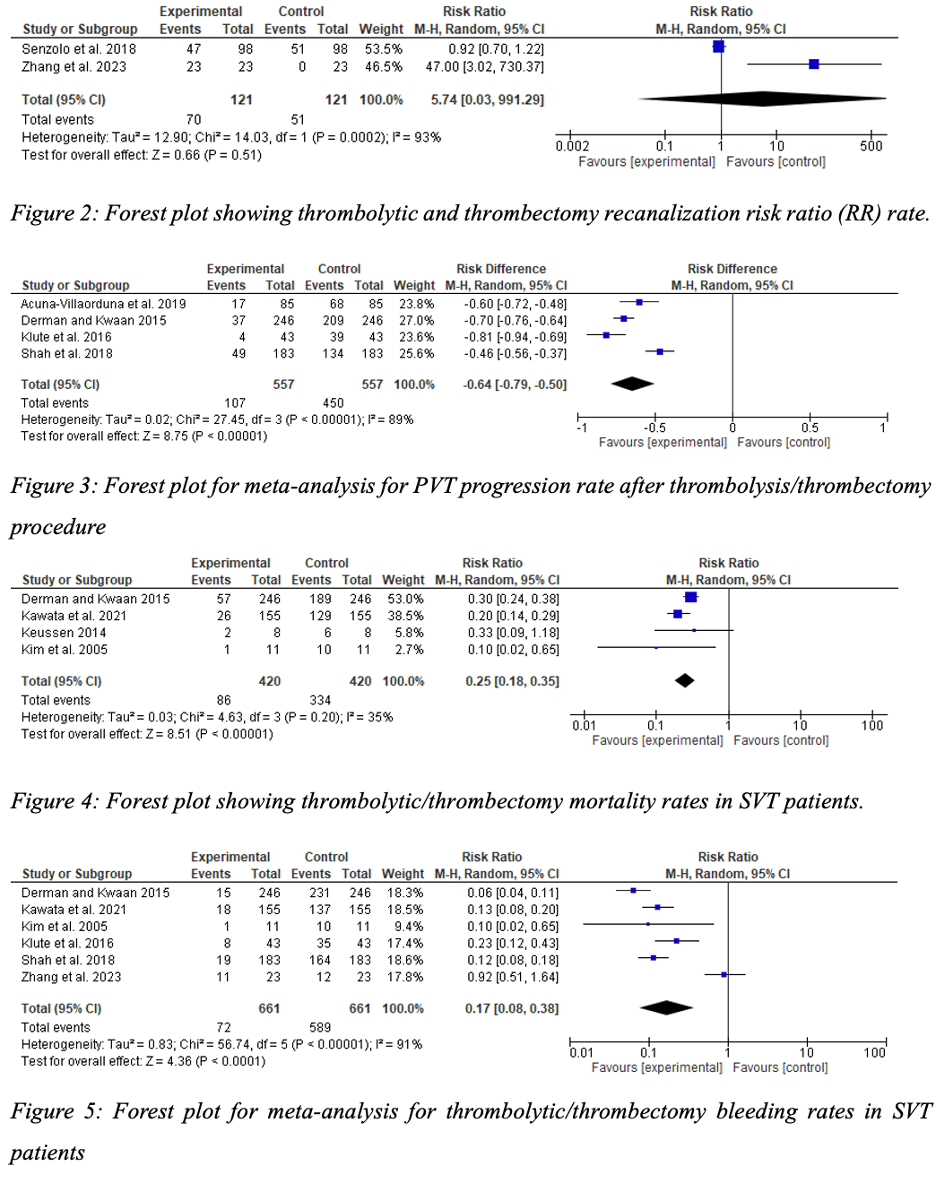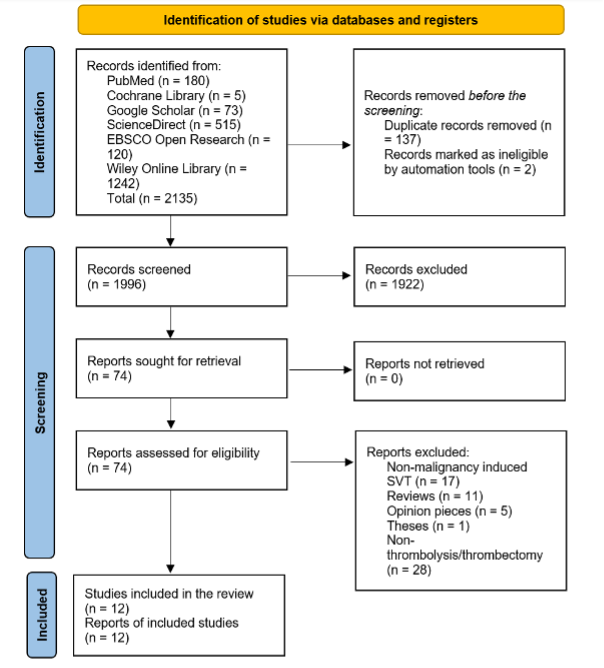Sunday Poster Session
Category: GI Bleeding
P0944 - Outcomes of Thrombolysis and Thrombectomy in Malignancy-Induced Splanchnic Vein Thrombosis: A Systematic Review and Meta-Analysis
Sunday, October 26, 2025
3:30 PM - 7:00 PM PDT
Location: Exhibit Hall
- VR
Vishal Ravella, MD
Marshfield Medical Center
Marshfield, WI
Presenting Author(s)
Venkata Pulivarthi, MD1, Vishal Ravella, MD2, Raghavendra Akhil Bogabathina, MD3
1East Tennessee State University, Johnson City, TN; 2Marshfield Medical Center, Marshfield, WI; 3Cookeville Regional Medical Center, Cookeville, TN
Introduction: Splanchnic vein thrombosis (SVT) is characterized by blood clot formation in the splanchnic venous system. In malignancy, SVT assumes particular clinical significance as cancer patients face a substantially elevated risk. Aggressive interventional approaches have been utilized, like catheter-directed thrombolysis and mechanical thrombectomy. To evaluate the efficacy, safety, and long-term outcomes of thrombolysis and thrombectomy interventions for managing malignancy-induced splanchnic vein thrombosis (SVT).
Methods: An all-inclusive search was conducted via PubMed, Cochrane Library, Wiley Online Library, ScienceDirect, EBSCO Open Research, and Google Scholar for research articles on the outcomes of thrombolysis and thrombectomy interventions for managing malignancy-induced SVT. The potential articles were screened against prespecified eligibility criteria. The risk of bias in the eligible studies was then evaluated using the Newcastle Ottawa Scale (NOS). Data were then procedurally extracted and analyzed.
Results: Twelve cohort studies were included in this analysis for 7822 patients. Thrombolysis/thrombectomy interventions significantly reduced portal vein thrombosis progression (RD -0.64, 95% CI: -0.79 to -0.50) and mortality (RR 0.23, 95% CI: 0.16 to 0.35, p< 0.00001) in malignancy-induced SVT compared to conventional management. While recanalization rates trended higher with interventional approaches (RR 7.72, 95% CI: 0.24 to 243.25), this finding was not statistically significant (p=0.25) with considerable heterogeneity (I²=93%). Intervention groups demonstrated significantly lower bleeding complications (RR 0.18, 95% CI: 0.09 to 0.36, p< 0.00001). Long-term outcomes varied by approach, with combined transjugular thrombectomy/thrombolysis achieving 88.2% secondary patency at 2-year follow-up.
Discussion: Thrombolysis/thrombectomy interventions offer significant benefits for malignancy-induced SVT, demonstrating reduced mortality and thrombosis progression compared to anticoagulation alone, with lower bleeding rates. However, technique-specific outcomes varied substantially, with mechanical and transjugular approaches showing promising durability.

Figure: Picture 1: PRISMA flow diagram (Page et al., 2021).

Figure: Picture 2: Forest plot for meta-analysis
Disclosures:
Venkata Pulivarthi indicated no relevant financial relationships.
Vishal Ravella indicated no relevant financial relationships.
Raghavendra Akhil Bogabathina indicated no relevant financial relationships.
Venkata Pulivarthi, MD1, Vishal Ravella, MD2, Raghavendra Akhil Bogabathina, MD3. P0944 - Outcomes of Thrombolysis and Thrombectomy in Malignancy-Induced Splanchnic Vein Thrombosis: A Systematic Review and Meta-Analysis, ACG 2025 Annual Scientific Meeting Abstracts. Phoenix, AZ: American College of Gastroenterology.
1East Tennessee State University, Johnson City, TN; 2Marshfield Medical Center, Marshfield, WI; 3Cookeville Regional Medical Center, Cookeville, TN
Introduction: Splanchnic vein thrombosis (SVT) is characterized by blood clot formation in the splanchnic venous system. In malignancy, SVT assumes particular clinical significance as cancer patients face a substantially elevated risk. Aggressive interventional approaches have been utilized, like catheter-directed thrombolysis and mechanical thrombectomy. To evaluate the efficacy, safety, and long-term outcomes of thrombolysis and thrombectomy interventions for managing malignancy-induced splanchnic vein thrombosis (SVT).
Methods: An all-inclusive search was conducted via PubMed, Cochrane Library, Wiley Online Library, ScienceDirect, EBSCO Open Research, and Google Scholar for research articles on the outcomes of thrombolysis and thrombectomy interventions for managing malignancy-induced SVT. The potential articles were screened against prespecified eligibility criteria. The risk of bias in the eligible studies was then evaluated using the Newcastle Ottawa Scale (NOS). Data were then procedurally extracted and analyzed.
Results: Twelve cohort studies were included in this analysis for 7822 patients. Thrombolysis/thrombectomy interventions significantly reduced portal vein thrombosis progression (RD -0.64, 95% CI: -0.79 to -0.50) and mortality (RR 0.23, 95% CI: 0.16 to 0.35, p< 0.00001) in malignancy-induced SVT compared to conventional management. While recanalization rates trended higher with interventional approaches (RR 7.72, 95% CI: 0.24 to 243.25), this finding was not statistically significant (p=0.25) with considerable heterogeneity (I²=93%). Intervention groups demonstrated significantly lower bleeding complications (RR 0.18, 95% CI: 0.09 to 0.36, p< 0.00001). Long-term outcomes varied by approach, with combined transjugular thrombectomy/thrombolysis achieving 88.2% secondary patency at 2-year follow-up.
Discussion: Thrombolysis/thrombectomy interventions offer significant benefits for malignancy-induced SVT, demonstrating reduced mortality and thrombosis progression compared to anticoagulation alone, with lower bleeding rates. However, technique-specific outcomes varied substantially, with mechanical and transjugular approaches showing promising durability.

Figure: Picture 1: PRISMA flow diagram (Page et al., 2021).

Figure: Picture 2: Forest plot for meta-analysis
Disclosures:
Venkata Pulivarthi indicated no relevant financial relationships.
Vishal Ravella indicated no relevant financial relationships.
Raghavendra Akhil Bogabathina indicated no relevant financial relationships.
Venkata Pulivarthi, MD1, Vishal Ravella, MD2, Raghavendra Akhil Bogabathina, MD3. P0944 - Outcomes of Thrombolysis and Thrombectomy in Malignancy-Induced Splanchnic Vein Thrombosis: A Systematic Review and Meta-Analysis, ACG 2025 Annual Scientific Meeting Abstracts. Phoenix, AZ: American College of Gastroenterology.
